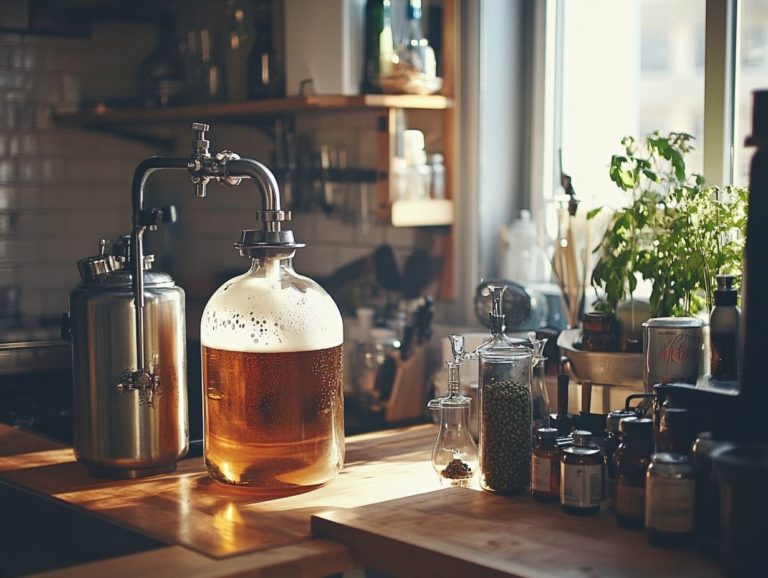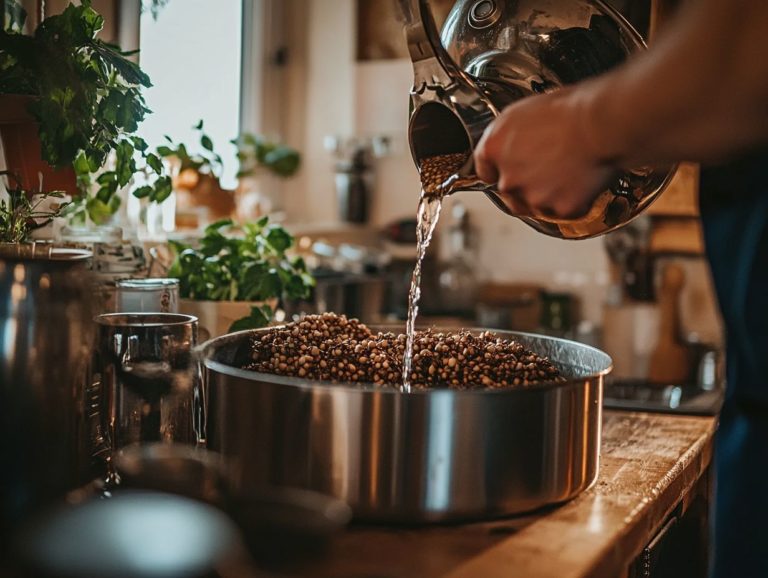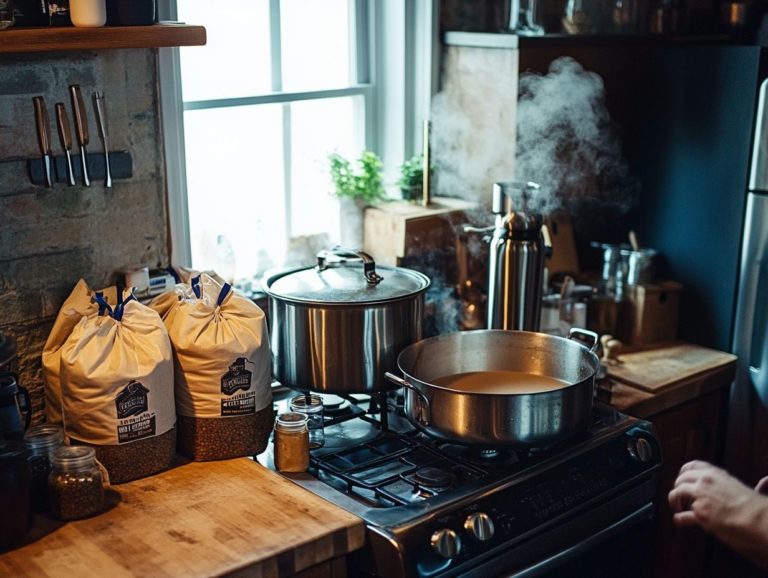The Importance of Sanitization in Home Brewing
Sanitization stands as a crucial pillar in the art of homebrewing, capable of transforming your final product from mediocre to magnificent. Without meticulous sanitization, you expose your brew to the perilous threat of unwanted bacteria and wild yeast, jeopardizing your painstakingly crafted masterpiece.
This guide delves into the essence of sanitization, unraveling its significance in achieving successful homebrewing and highlighting the risks that come with neglecting this essential practice. You’ll discover various sanitization methods, along with expert tips from Jeff Flowers and Dave Carpenter for effectively cleaning your equipment and avoiding common pitfalls.
Whether you re just embarking on your brewing journey or are already a seasoned enthusiast, maintaining a pristine environment is your gateway to brewing excellence. Are you ready to elevate your homebrew game?
Contents
- Key Takeaways:
- What Is Sanitization?
- Why Is Sanitization Important in Home Brewing?
- What Are the Different Methods of Sanitization?
- How to Properly Sanitize Your Home Brewing Equipment?
- 1. Clean First
- 2. Choose the Right Sanitizer
- 3. Follow Instructions and Drying Time
- What Are Some Common Mistakes in Sanitization?
- How Often Should You Sanitize Your Home Brewing Equipment?
- Frequently Asked Questions
Key Takeaways:
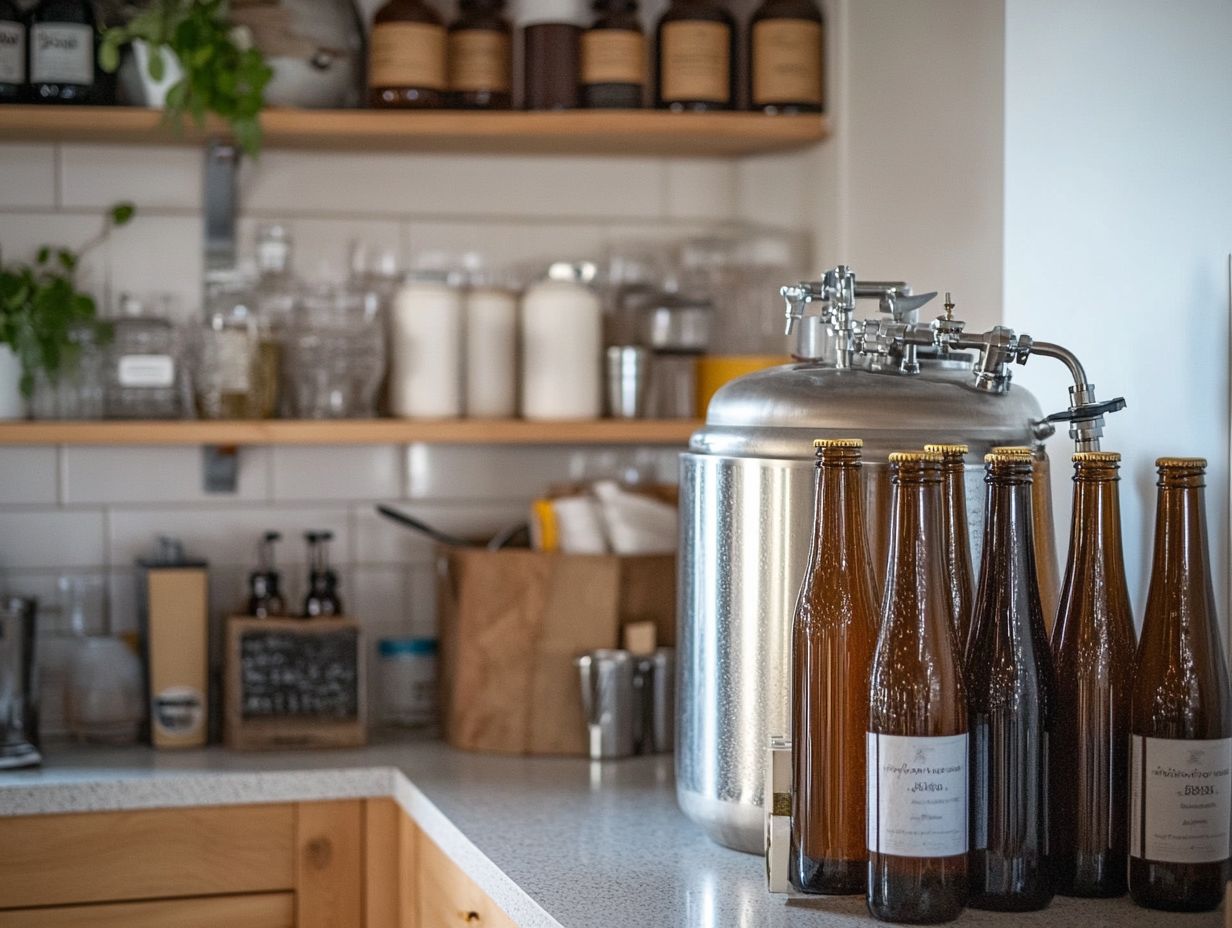
- Proper sanitization is crucial for successful home brewing, as it eliminates harmful bacteria and ensures a clean environment for yeast to ferment.
- Not properly sanitizing equipment can lead to off-flavors, contamination, and even serious health risks.
- There are various methods of sanitization, but it is important to choose the right sanitizer and follow instructions for optimum effectiveness.
What Is Sanitization?
(April 4, 2014)
Sanitization is an essential process involving the meticulous cleaning and disinfecting of surfaces and brewing equipment to eradicate harmful bacteria and microorganisms that could jeopardize your homebrewing operations.
In the art of homebrewing, where the journey begins with boiling wort (the liquid extracted from the mashing process that contains sugars for fermentation), the threat of bacterial infection looms large. It can compromise the fermentation process if your brewing equipment isn’t properly sanitized. Ensuring proper sanitization can make the difference between a successful fermentation and an infected batch.
Utilizing effective sanitizers like Star San, Iodophor, and sodium metabisulfite is crucial. These ensure your fermentation vessels, carboys, and cleaning tools are free from pathogens before use. Oxygen-based and acid-based sanitizers are also beneficial. This practice is vital for preserving the integrity of your brewing process and securing the quality of your beer.
Why Is Sanitization Important in Home Brewing?
(October 23, 2018)
Sanitization is crucial in homebrewing, significantly influencing the quality, safety, and flavor of your final product. By ensuring proper sanitization, you prevent the unwelcome presence of bacteria and microorganisms such as Lactobacillus, Pediococcus, and Acetobacter. These can compromise the wort and introduce off-flavors, not to mention jeopardize the safety of your brew. Effective sanitization practices eliminate health risks associated with contaminated brewing equipment.
Skipping effective sanitization puts your hard work and investment at risk. It is essential to utilize reliable sanitizers and meticulously clean your brewing equipment, including any immersion wort chillers you might use. Prioritizing these steps not only enhances your brewing experience but also elevates the quality of your creations.
What Are the Potential Risks of Not Sanitizing Properly?
Neglecting to properly sanitize your homebrewing equipment can expose you to various risks that may jeopardize both the safety and quality of your beer. Bacterial infections from microorganisms like Lactobacillus, Pediococcus, and Acetobacter can lead to spoilage, resulting in off-flavors and potentially ruining an entire batch. These unwelcome bacteria thrive in unclean environments, which is why the sanitization process is essential for protecting your fermentation and ensuring your brewing equipment remains free from harmful germs.
Inadequate sanitation can introduce these bacteria into your brewing process. They can create lactic acid a compound that can give your beer a sour taste or vinegar-like flavors, drastically altering your intended taste profile. For example, Lactobacillus can impart a sour characteristic you didn t plan for, while Acetobacter can introduce unpleasant vinegar notes. Such contaminants can ruin a batch of beer, causing clumping or haziness that makes it unappealing to drinkers.
To brew the best beer possible, it’s vital to stick to effective sanitization practices! This not only protects the integrity of the flavors but also safeguards the overall quality of your brew, ensuring that each sip reflects your true intentions as a brewer. Proper cleaning practices using the right sanitizers like PBW, along with regular maintenance of your equipment, will help you achieve the best results.
What Are the Different Methods of Sanitization?
You have a variety of effective sanitization methods at your disposal to ensure your brewing equipment is free from harmful bacteria and microorganisms. Consider employing chemical sanitizers, heat sanitization, or UV sanitization, each of which offers unique advantages tailored to your needs. The right approach can ensure the safety and quality of each batch you brew.
Chemical sanitizers, such as oxygen-based and acid-based options like iodine-based solutions such as Iodophor and Five Star PBW provide comprehensive coverage against a wide range of harmful germs. Proper use of these sanitizers ensures your brewing environment remains uncontaminated.
Heat sanitization methods leverage high temperatures to eliminate bacteria, assuring that your equipment remains safe for brewing.
UV sanitization is becoming popular as a non-chemical alternative that achieves an impressive level of cleanliness, making it a viable option for modern homebrewers looking for safe and efficient sanitization methods.
1. Chemical Sanitizers
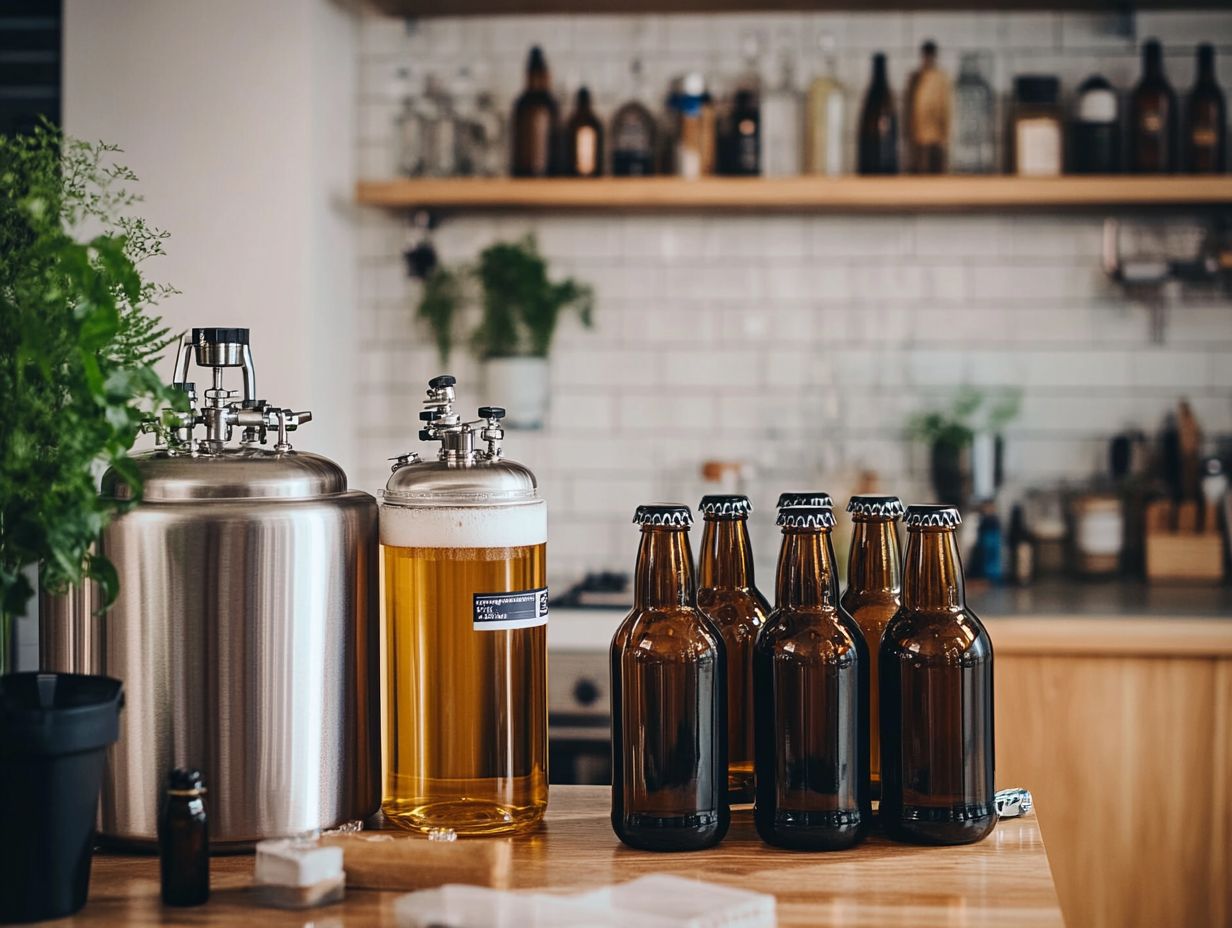
Chemical sanitizers are an excellent choice for you as a homebrewer looking to effectively eliminate bacteria from your brewing equipment. Notable options include Star San, an acid-based sanitizer, and Iodophor, an iodine-based sanitizer, both of which offer comprehensive protection against a wide range of pathogens. You might also consider sodium metabisulfite, renowned for its ability to prevent oxidation and inhibit microbial growth, as well as Five Star PBW for thorough cleaning. This makes chemical sanitizers a reliable ally in ensuring the safety and cleanliness of your fermentation equipment.
It’s essential for you to recognize that each type of chemical sanitizer has its recommended concentration and contact time to achieve optimal effectiveness. For instance, Star San is typically used at a concentration of 1 ounce per 5 gallons of water, requiring a contact time of at least 30 seconds. Iodophor usually calls for a dilution of 1-2 ounces per 5 gallons, with a contact period of about 1-2 minutes.
While sodium metabisulfite proves effective, its potent odor can be a bit off-putting, so careful handling is imperative. To ensure your safety and the effectiveness of your sanitizing efforts, always wear gloves and protective eyewear, and make sure your brewing area is well-ventilated.
You should frequently monitor the concentration levels of these sanitizers to avoid under-dilution, which could lead to inadequate sanitation. Maintaining these practices will elevate your homebrewing experience and help you produce quality brews with confidence.
2. Heat Sanitization
Heat sanitization stands out as an exceptionally effective technique for ensuring your brewing equipment remains free from harmful microorganisms. This method typically involves either boiling water or using a steam sanitizer to expose your gear to high temperatures. It effectively eradicating bacteria and other pathogens.
It’s particularly beneficial for items designed to withstand high heat, such as stainless steel fermentation vessels and immersion heaters. This allows for a thorough cleaning process while prioritizing a safe brewing environment.
To achieve optimal results, you should maintain temperatures of at least 180 F (82 C) for a minimum of 30 seconds. This duration has proven effective in eliminating most harmful bacteria. Various tools, such as commercial steamers or immersion heaters, can facilitate this process efficiently, ensuring all your brewing equipment is sanitized.
Be mindful that certain materials, like plastics or rubber gaskets, may not withstand prolonged exposure to such high temperatures without warping or degrading. Every homebrewer must consider this limitation carefully. Also, always ensure your equipment is compatible with heat sanitization methods.
So, while heat sanitization is an outstanding method that every homebrewer should embrace, it s crucial to evaluate the compatibility of your equipment before diving in.
3. UV Sanitization
UV sanitization presents an innovative and chemical-free approach that harnesses the power of ultraviolet light to eradicate harmful microorganisms from your brewing equipment. By simply exposing surfaces to UV light for a predetermined duration, you effectively disrupt the DNA of bacteria, thwarting their ability to reproduce.
While this technique does call for specialized equipment, it offers you a convenient solution to maintain a safe brewing environment without relying on chemical sanitizers. UV sanitization is particularly effective for hard-to-reach areas where traditional sanitizers might not be as effective.
A variety of UV equipment is at your disposal, ranging from portable handheld devices to larger fixed units, each tailored to meet different sanitization requirements. These devices proficiently tackle a spectrum of pathogens, from common bacteria to more resilient viruses, granting you peace of mind as you uphold hygiene standards in your brewing process.
While UV sanitization comes with a host of benefits including speed and the absence of harmful residues there are some caveats. These include challenges in reaching shaded areas and the need for careful handling to avoid UV exposure to your skin and eyes.
To maximize the effectiveness of UV sanitization, it s essential to adopt best practices. Ensure that surfaces are clean prior to treatment and regularly check your equipment’s functionality. By doing so, you can achieve optimal results and enjoy the benefits of a safe and sanitary brewing environment.
How to Properly Sanitize Your Home Brewing Equipment?
Sanitizing your home brewing equipment properly is a multi-step process that is crucial for ensuring both the safety and the quality of your final product. Start by thoroughly cleaning all your brewing equipment to eliminate any residue or contaminants.
After that, choose the right sanitizer Star San or Iodophor are excellent options to effectively eradicate any lingering bacteria and microorganisms. It s vital to follow the specific instructions for application and drying time to ensure that surfaces are adequately sanitized before they come into contact with wort or the fermentation process.
Taking these steps will elevate your brewing experience and help you achieve exceptional results.
1. Clean First
The first step in sanitizing your home brewing equipment is to engage in a thorough cleaning. This essential process keeps unwanted bacteria away and eliminates dirt, residue, and contaminants that could spoil your brew. To achieve effective cleaning, it’s wise to use appropriate cleaning agents, like Five Star PBW. Ensure that all surfaces are devoid of grime before you apply any sanitizer. By meticulously cleaning your brewing equipment think large brewing containers and cooling devices for wort you lay a solid foundation for successful sanitization.
This comprehensive approach not only elevates the cleaning process but also significantly enhances sanitization, ensuring that each fermentation batch remains safe and free from contamination.
Regarding cleaning fermenters, consider scrubbing with a mixture of warm water and a gentle detergent specifically designed for brewing. A soft brush will allow you to reach every nook and cranny without scratching those delicate surfaces.
For your stainless steel equipment, remember that it requires a bit of special attention. Using a non-abrasive cleaner will not only preserve its pristine finish but also effectively remove any gunk. After cleaning, rinsing thoroughly is crucial; any residue from cleaning agents could negatively influence the flavors of your final brew.
2. Choose the Right Sanitizer
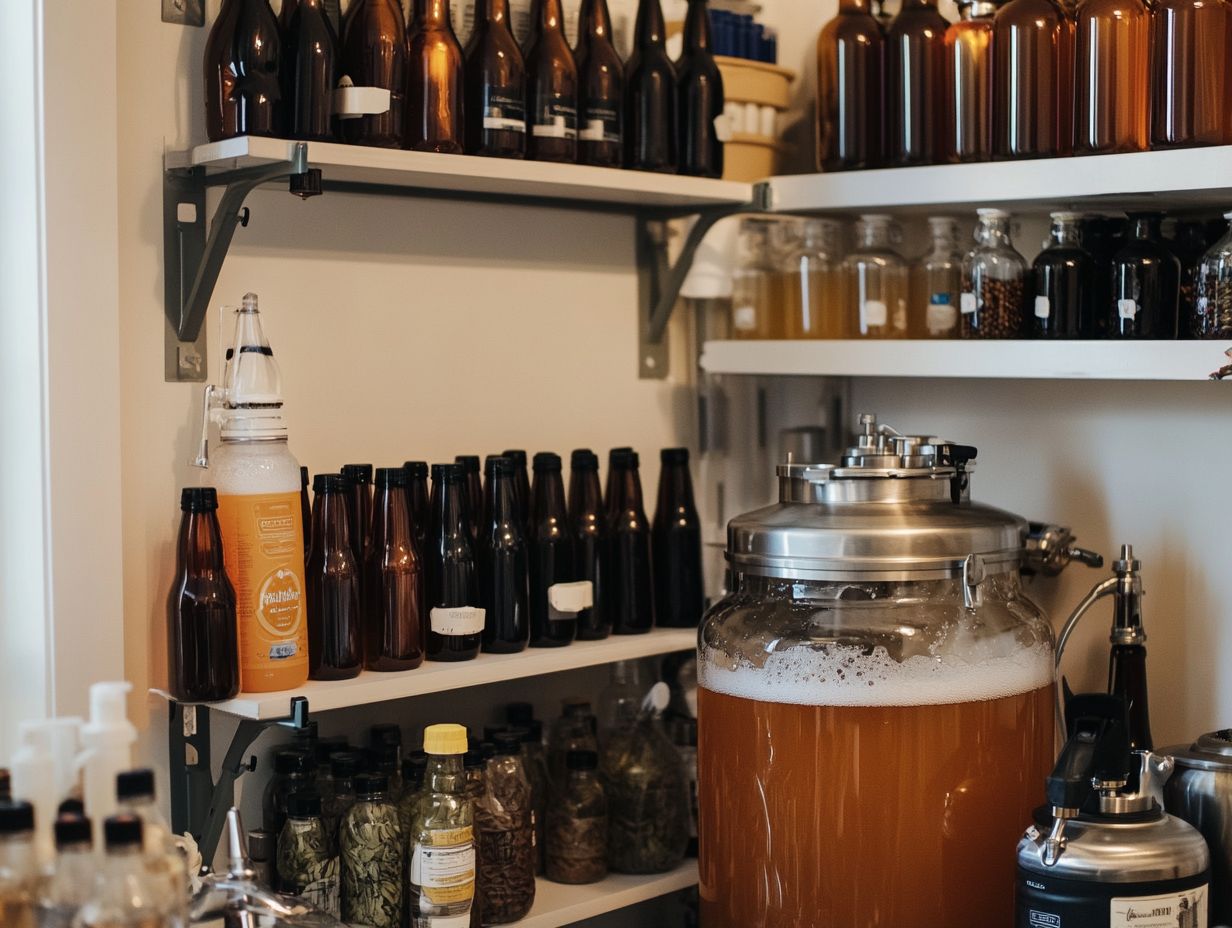
Choosing the right sanitizer is essential for ensuring your brewing equipment is effectively sanitized and plays a significant role in the safety of your beer. You have popular options like Star San, revered for its no-rinse quality, and Iodophor, a reliable iodine-based solution. By understanding the unique properties of these sanitizers, you can select the most suitable option for your specific cleaning equipment.
Star San s effectiveness shines through its ability to eliminate a wide range of organisms on contact, making it a top choice among home brewers. Its foaming action can be a double-edged sword; too much foam can lead to oversaturation and wasted product. On the flip side, Iodophor provides a gentler approach but requires a thorough rinse to prevent any lingering iodine taste in your final brew.
Ultimately, your choice of sanitizer should resonate with your own preferences, whether that s ease of use or the convenience of a no-rinse option. This decision should harmonize with your brewing equipment material, desired brewing timeline, and overall hygiene objectives.
3. Follow Instructions and Drying Time
Following the instructions for your chosen sanitizer is essential to ensure effective sanitization and safety throughout your brewing process. Each sanitizer comes with specific contact times and dilution ratios that you must adhere to for optimal results. It s crucial that your brewing equipment is completely dry after sanitizing; any moisture can dilute the sanitizer, diminishing its effectiveness and increasing the risk of microbial contamination.
Neglecting these vital factors could inadvertently compromise the quality of your final product, leading to off-flavors or spoilage that no brewer wants to face. Understanding the science behind sanitization gives you the power to maintain a consistent and reliable brewing environment.
By exercising proper diligence in these areas, you not only guarantee a safe and effective brewing process but also cultivate a culture of quality control and responsibility. Committing to these practices makes brewing easier and more enjoyable for you and everyone who gets to taste your beer!
Start cleaning and sanitizing your equipment now for the best brewing results!
What Are Some Common Mistakes in Sanitization?
Common mistakes in sanitization can undermine even your best homebrewing efforts. These errors can lead to potential contamination and compromise the quality of your final product. Often, these mistakes involve skipping the cleaning phase, using insufficient amounts of sanitizer, or failing to follow recommended contact times.
By understanding these pitfalls, you can take the necessary precautions to ensure your brewing equipment is properly sanitized for successful fermentation. It’s important to recognize that neglecting thorough cleaning before sanitizing can leave behind residues that harbor unwanted microbes.
Using a diluted sanitizer or cutting corners on the required soaking time can drastically reduce its efficacy. This can allow harmful bacteria to thrive.
To avoid such pitfalls, creating a checklist that outlines each step of the sanitization process is advisable. This strategy will help ensure that every piece of equipment is appropriately cleaned and treated. Regularly reviewing your sanitization protocols enhances the safety and taste of your brew, reinforcing your commitment to quality and authenticity in your craft.
How Often Should You Sanitize Your Home Brewing Equipment?
As a homebrewer, it’s essential to take a proactive approach to sanitizing your brewing equipment. This ensures the highest level of safety and quality in your beer. Ideally, you should sanitize all your equipment before each brewing session, particularly after any prior use or cleaning, to eliminate any lingering bacteria.
By adopting regular and thorough sanitization practices, you not only protect the fermentation process but also preserve the integrity of your homebrewing experience.
Consider your glass carboys, bottles, and fermenters. These vital tools demand consistent attention to cleanliness, especially as you transition from newly purchased items to those that have seen previous use. New equipment might still carry packaging residues that could impact your final product, while older items may harbor stubborn contaminants. Establishing a routine for sanitizing all your equipment before use is crucial.
The type of brewing system you choose can also dictate how often you need to clean. For instance, all-grain systems often require more frequent cleanings due to their complexity compared to simpler setups. Ultimately, maintaining these practices is vital for achieving the desired flavors and ensuring the safety of your brews.
Frequently Asked Questions
What is the importance of sanitization in home brewing?

Sanitization in home brewing is crucial because it helps prevent contamination and off-flavors in your beer. This ensures a clean and safe end product.
How can I properly sanitize my brewing equipment?
There are several methods for sanitizing your equipment:
- Using a sanitizing solution
- Boiling
- Using heat from your oven
It’s important to follow the instructions and ensure all surfaces and equipment are properly sanitized.
What happens if I don’t properly sanitize my equipment?
If your equipment is not properly sanitized, it can lead to the growth of bacteria, wild yeast, or other microorganisms. This can result in off-flavors and potentially make your beer undrinkable.
Is it necessary to sanitize everything in the brewing process?
Yes, it’s important to sanitize everything that will come in contact with your beer during the brewing process. This includes equipment, utensils, and even your hands. Doing so helps to prevent any potential contamination.
How often should I sanitize my equipment?
You should sanitize your equipment before each use, even if it has been stored properly. This ensures that any potential bacteria or microorganisms are eliminated before coming into contact with your beer.
Can I reuse sanitizing solution?
No, sanitizing solution should be discarded after each use. Reusing solution can lead to contamination and defeat the purpose of sanitizing in the first place.
Adopting these sanitization practices is critical for maintaining the quality of your brews. Don t wait ensure your home brewing equipment is sanitized and ready for your next batch!


